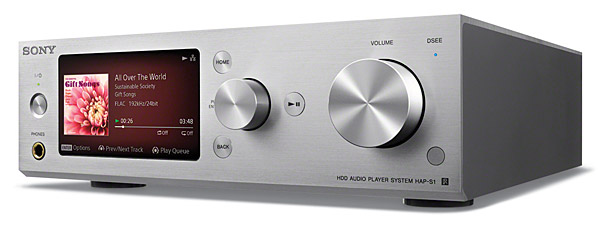Sony HAP-S1 High-Resolution Audio Player Page 2
 Be Right with You
Be Right with You
The system takes 15 seconds to boot. With network connection, make that 22 seconds. The home screen contains exactly what you’d expect: Now Playing, Genres, Artists, Albums, Tracks, Playlists, Favorites, Internet Radio, Inputs, and Settings. Sony throws in a wild card of its own: the SensMe channels, which group tracks by Morning, Daytime, Evening, Night, Midnight, Energetic, Relax, Mellow, Upbeat, Emotional, Lounge, Dance, and Extreme. There’s no way to add or rename channels, so if you were thinking of adding Doc, Dopey, Bashful, Gus, Tuco, Jesse, and Mr. White, you’re out of luck.
On the Now Playing screen, the art appears at left, and text in an attractive font tells you everything you’d want to know: track, artist, album, file format, bit depth, sampling rate, elapsed time, total time, Wi-Fi status, and a few navigational aids. It’s all there and beautifully organized.
With modest power and no sub, the HAP-S1 delivered a resolutely lightweight and small-scaled presentation on the Eras. Midbass and lower frequencies were understated. While the top end was on the polite side, it wasn’t uncommunicative or devoid of sparkle with electric guitars or violins. High-rez material (DSD, 24-bit FLAC, and WAV) was clearly more refined than lossy material (MP3). The distinction between HRA and CD-quality material (from Apple Lossless rips and actual CDs) was narrower and, frankly, sometimes hard to discern with the internal amp. But lossless 16- and 24-bit files invariably imaged better than lossy ones.
My listening started in the middle ground with Guitarra Española, a five-CD set of Spanish classical guitarist Narciso Yepes, ripped in ALAC. The Sony did a good job of defining Yepes’ shimmering runs, but it downplayed the bottom strings of his self-designed 10-string guitar.
Moving up into high-rez territory, I auditioned some 48/24 FLACs from the B&W Society of Sound—including Bruckner’s Fourth Symphony and Beethoven’s Fifth, with Bernard Haitink conducting the London Symphony Orchestra. The timbre and texture were there, but the kettledrums barely were, and the soundstage didn’t have the kind of room-filling scale a more powerful amp would afford.
Sony provided a selection of preloaded HRA test tracks—including DSD, FLAC, and WAV—all of which I perused. Among the DSD tracks were well-known pieces from Sony Music artists, such as the Dave Brubeck Quartet, Herbie Hancock, James Taylor, and Miles Davis. I’m familiar with those tracks on either LP or CD, and they sounded more like my memories of vinyl than anything else—minus the surface noise—with a welcome lack of edginess and grain. While they offered no sudden insight or dramatic catharsis, listening to them just felt right, somehow.
The fast-food and wine industries use the term mouthfeel to refer to the sensations of food or drink from the first impact on the palate to the aftertaste. The DSD tracks had a good earfeel. (Make that earfeel™. If you use the term, you have to pay me.) Their warm, clean, well-structured midrange allowed me to relax into the music from the first notes to the last—plus that brief afterglow when the music goes silent, just before the feeling slips away. My attention didn’t wander, as it so often does with low-rez audio.

This is usually my reaction to high-rez audio in general. Having spent so little time with DSD, except via SACD, I remain agnostic on whether it’s a higher-rez file format than FLAC or other 24-bit-capable PCM formats. To my ears, both sound better than CD—not always, but enough of the time to be worth pursuing.
On the last demo day, I connected the player’s analog output to my main reference system, with a Pioneer VSX-53 A/V receiver, Paradigm Reference Studio 20 v.4 speakers, and Seismic 110 sub. In word, wow. Of course, the bass was better filled in. But it was also warm, natural, tuneful, and refined in a way that was spellbinding. In fact, that described the sound from bottom to top. I wouldn’t say the DSD difference was that obvious with Miles Davis’ “So What”; doesn’t that track sound great in every format? But the woodwinds in Herbie Hancock’s “Watermelon Man,” the piano in Dave Brubeck’s “Blue Rondo à la Turk,” and pretty much everything in Blood, Sweat & Tears’ “Spinning Wheel” took a step forward in fidelity and momentum. It was compelling earfeel all over again, but more intense this time, and it made me want to hear more and more DSD.
The Sony HAP-S1 is a promising start to the company’s HRA initiative. As a player, it does a superb job, with an interface that makes accessing music not only easy but fun. That’s one of the things a big company like Sony can bring to the table: showmanship. And the DAC is first-rate. As for the amp, it’s good enough for casual desktop use, but it doesn’t deliver the maximum resolution of which DSD and 24-bit files are capable. Best to think of the included poodle amp as a neat add-on to an already excellent combo of HRA player-server, DAC, and headphone amp. Even with its limitations, at less than $1,000, the HAP-S1 represents great value and makes a marvelous introduction to high-rez audio.






























































